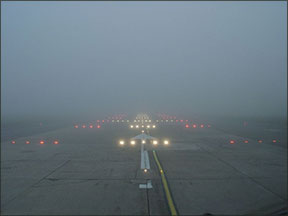Back in the 1950s, social critic and philosopher Lenny Bruce said that no one is shocked anymore. He was probably correct, given our national tolerance for the excesses of those in the entertainment biz, and those seeking to join the weirdness. Yet, I find my level of amazement at flight schools that grind out new instrument pilots without insisting that they actually fly an airplane in the clouds remains at the near shock level.

288
Let’s get the legalities out of the way right here—the FARs, in one of the universe’s great cosmic jokes, do not require pilots to log a moment of time flying in the clouds to obtain an instrument rating. That’s right, zip, nada, bupkiss. Yet, upon being so certificated, the neophyte may legally blast off into absolute zero-zero conditions under Part 91 and shoot whatever approach his or her little heart desires, in whatever weather happens to be present. Legally, the pilot can’t actually land unless the visibility meets published minimums upon reaching the missed approach point, but one can’t help but wonder if he will make it that far.
I know better than to propose the FAA amend its regulations; I’ve seen the monumental botch the agency made of the new regulations for the ATP. Rather, I suggest we take a hard look at why a pilot should get her initial experience in the clouds with an instructor in the right seat—and then come up with a strategy to get an education in the clag.
Simulator vs. Airborne
Up front, I’ll readily admit it’s easier to carry out the monkey motion of keeping the airplane right side up when actually in the clouds than it is under the hood. That is one of the many surprises pilots get when flying in the clouds the first time. Being able to look around the cockpit and scan comfortably is delightful after the restrictions of the hood. Whether it’s easier in the airplane or the simulator depends on the quality of the simulator. I like simulators. A lot. They’ve cut the training accident rate dramatically and eliminate the risk of learning and practicing emergencies in the airplane. But, they simply cannot recreate the intense emotional reactions dramatically affecting a pilot those first several times he shoots an approach in the clouds.
There is no way to simulate the surging in the bowels a pilot experiences when shooting an approach to minimums as the rain hoses against the windshield in a roar that nearly blanks out the ability to think. It cannot duplicate the overwhelming urge to urinate—a new, unpleasant and dominating distraction that somehow causes the needles to refuse to cooperate. The simulator does not provide the intense awareness of the fact the cold, hard ground isn’t far away felt when it’s for real.
Driving an electronic box in a classroom doesn’t recreate how you feel when your attention is fragmented—as you approach minimums—by trying to decide if you are going to try the approach again if you miss or if fuel is going to demand that you go to the alternate but, wait a minute, there were two laps around the hold and you didn’t pull the power back…there may not be enough gas to divert. Plus, the car is parked here.
I suggest that it might be wise to have an instructor in the right seat the first time you embark on this adventure.
Complications Arise
Not convinced? Okay, take the same situation and let our new pilot break out at minimums. Let’s say the visibility is, at most, a mile. Remember the first time you had to make the transition from the gauges to the visual line up and landing? Precision approach or not, chances are some sort of turn is going to be necessary to align with the runway. There is no horizon. A pilot who has not seen a mile visibility must climb a steep learning curve to successfully figure out where to look for visual cues that will allow making it to the runway.
I’ve looked at too many accidents where the pilot shot the approach to a spot very near the airport and then lost it while maneuvering for the runway. In some, where I had access to the pilot’s logbooks, I found that he’d never shot an approach in visibility less than three miles.

The world looks different when the visibility gets down to two miles or less. The absence of information is stunning to the senses of those who have little experience with it. It’s one of the reasons that VFR into IMC is so deadly.
If you add circling to land to the mix for an instrument pilot who has never flown when visibility stinks, the odds of successful completion drop. I can’t count the number of instrument rated pilots I’ve flown with on recurrent training who have flown their circle-to-land pattern more than a mile from the runway even though we’d agreed we were simulating one-mile visibility. Hmmm, how would you rate the risk factor for a pilot who has spent a few years flying the pattern at 1000 feet agl, in at least five-mile visibility, about to shoot an approach and circle under a 500-foot ceiling with visibility of less than two miles, when he has never shot an approach in clouds in his life?
Reality means some pilots get instrument ratings without having a chance to fly in IMC—things just don’t work out.
What to do about it
There is hope. There are instructors who do their best to ensure their instrument students get to see what the transition to visual references looks like in crummy conditions after an approach through the clouds and rain or snow. There are ethical flight schools—the ones that don’t park their trainers when the weather is less than 3000 and five—that take students out to experience the glorious feeling of popping out of the top of an overcast after departing on a gray, depressing day.
If you are an instrument student, or an instrument-rated pilot who has limited time in the clouds, may I suggest a strategy for expanding your real world knowledge and improving your decision-making skills?
Sit down with an instructor you trust and respect and tell her that you want to get some actual IMC experience or, at the very least, some flights when the visibility is less than three miles. A good instructor will welcome your approach and work with you to set things up. She also will refuse to intentionally enter a thunderstorm.
Actively watch for IFR days and go flying. If you can be flexible in scheduling, it can be a benefit for you and your instructor. Your instructor usually has to cancel VFR students on IMC days—just let it be known you’ll come zipping out to the airport if your instructor calls you. Instructors have to eat. Good ones set up this sort of arrangement with their instrument students—often advising them to stand by a day or so ahead of time if the forecast looks favorable for a little actual IFR.
Much of the country has days when there is an overcast that is a few thousand feet thick. File and go fly in it—request an altitude that will keep you in the clouds, then request an altitude that will put you on top and see how things change as you approach the tops and break through. It can be deceptive. ATC has heard the phrase “just another 1000 feet and I’ll be on top” from optimistic pilots for generations. (John Glenn was rumored to have uttered it as a joke during his first space flight, but recently told us he doesn’t recall the comment.) Getting the experience in controlled circumstances may keep you alive someday when there is ice in the clouds—it’s at its worst in the tops. Recognizing that you really do have a ways to go to break out may keep you from vainly trying to climb the last 1000 feet through ice that will bring you down.
Great Expectations
A reality of instrument training and instrument flight in general is that more than 99 percent of approaches result in the pilot seeing the runway and landing. An expectation of success becomes a mindset. I’ve watched it in pilots during recurrent training when things have worked out for them to shoot an approach where we did not break out before reaching minimums. In some cases it was like watching someone go through Elizabeth Kübler-Ross’ steps on death and dying before they accept the fact that they really are going to have to miss the approach and then do something about it: Denial, anger, bargaining, depression and acceptance. I’ve watched pilots fly along for a mile past the missed approach point on a non-precision approach before adding power to start the miss.
In my opinion, it’s a good idea for a pilot to have an instructor along the first time she experiences nothing but gray when she looks up at DA.
Step out of the security of the simulator and fly IMC with an instructor before you do it by yourself. Work up a strategy, be flexible and go fly in weather—have someone experienced beside you as those clouds get incredibly dark near the bottom, you wonder if you’re going to see the runway before minimums, you badly want to land and you are aware of the looming presence of the terrain. If you screw up in the simulator, it has a reset button. Real life doesn’t.
Rick Durden is the Senior Editor of sister publication Aviation Consumer magazine, an aviation lawyer and author of The Thinking Pilot’s Flight Manual.




